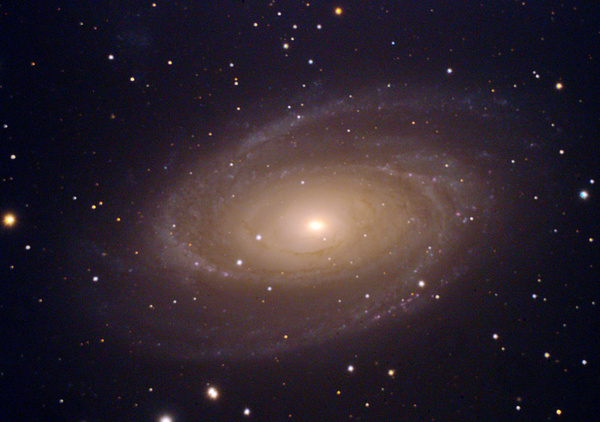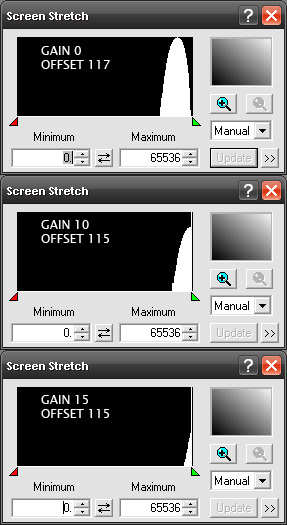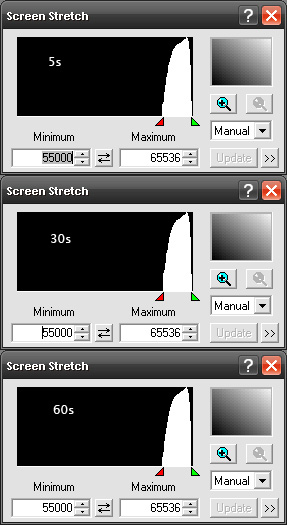Also ich habe den Ascom Treiber von astrosoft.be und schneller Download an - ein anderer Treiber lief mit AstroArt nicht.
Beim schnellen Download hab ich auch am Bias Histogramm eine schöne Kurve (siehe oben). Beim langsamen nicht - da hab ich einen Buckel rechts und der ist um einiges breiter.
Hab gestern Abend eine Serie von Bildern einer entfernten Kirche gemacht - mit Gain ohne Gain, langsam und schnell. Schauen fast alle gleich aus - nur am Histogramm sieht man einen kleinen Unterschied (Belichtung von 1 sec bis 30 sec.) - bei denen mit Gain fängt die Kurve weiter rechts an - ohne Gain schon früher. Heißt das nun, dass bei den Bildern ohne Gain "mehr" Information drinsteckt?
Craig schrieb dazu:
Let's come up with another example. Let's have one camera with a gain of 1. So, 1 e-/ADU. Let's have another run at 0.5 e-/ADU. Now, let's have a pixel with 1k e-, another with 10k e-, another at 30k e-, and another at 50k e-. In our 1 e-/ADU cam, we of course have intensities of 1000, 10000, 30000, and 50000. In our 0.5 e-/ADU cam, we have intensities of 2000, 20000, 60000, and 65535. What? Why not 100000? Well, our 16-bit camera has a fixed limit of 65535. Anything above that gets clipped off. So while the 1 e-/ADU camera can faithfully preserve this whole range, the 0.5 e-/ADU camera can't. Its dynamic range is limited now.
Weiters schreibt er die Vorgehensweise wie von Michael beschrieben:
So, how do I set it? (man, you ramble a lot when you get going!)
1) Take a bias frame and look for the minimum value in it. Is it at least, say 100 and less than a thousand or a few thousand? If so, your offset is fine. If it's too low, boost the offset. If it's high, drop it. Repeat until you have a bias frame with an offset in, roughly 100 - 1000. Don't worry about precision here, it won't matter at all in the end. You now know your offset. Set it and forget it. Never change it.
2) Aim the camera at something bright or just put it on your desk with no lens or lenscap on and take a picture. Look at the max value in the image. Is it well below 65k? If so, boost the gain. Is it at 65k? If so drop the gain. Now, if you're on a real target (daylight ones are great for this) you can look at the histogram and see the bunching up at the top end as the camera is hitting full-well. Having that bunch-up roughly at 65,535 plus or minus a bit is where you want to be. If you pull up just shy, you'll get the "most out of your chip" but you'll also have non-linearity up there. You've got more of a chance of having odd color casts on saturated areas, for example, as a result. If you let that just clip off, you've lost a touch but what you've lost is very non-linear data anyway (all this assumes, BTW, an ABG chip which all of these cams in question are). Record that gain and set it and forget it. Never change it.
Denke, so werd ich es machen - also die Belichtungszeit für die Tageslicht-Gain-Einstellung auf 1-2 Sekunden? Ist das nicht zu lange?
lg Rainer
Newton 30cm f4 (mit Paracorr f4,5, Skywatcher Spiegel, Helmi Carbontubus, Feathertouch, usb focus)
Losmandy Titan, Moravian 8300FW mit Astrodon HaLRGB Filter, 2,7m Pulsar Kuppel am Weerberg in Tirol
http://www.astrostammtisch.com





